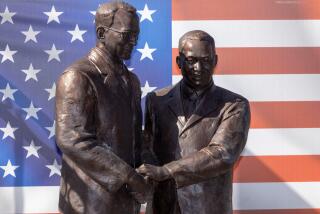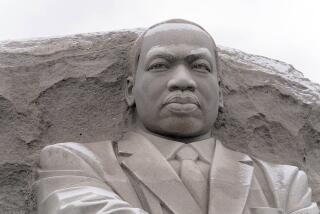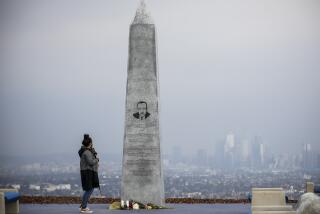When Martin Luther King Jr. took his fight into the North, and saw a new level of hatred
When the Rev. Martin Luther King Jr. stepped out of his car on Aug. 5, 1966, in his usual dark suit and polished shoes, he was met by a line of police and a mob of angry white people. His struggle hadn’t gotten easier.
As the 37-year-old civil rights leader strode toward several hundred supporters, a stone sailed through the air and struck King, sending him to one knee. Aides shielded the Nobel laureate from bricks and bottles hurled by the furious crowd.
King had faced violence before. But this time, he wasn’t in the Jim Crow South. He was in Chicago.
Fifty years ago this January, King embarked on a less-remembered chapter from the final years of his life, a battle that ultimately went unfinished — a campaign against poverty and de facto segregation in the North that was met with institutional resistance, skepticism from other activists and open violence.
“I have never seen, even in Mississippi and Alabama, mobs as hateful as I’ve seen here in Chicago,” King told reporters that day, stripping off his tie and vowing to continue demonstrating. “Yes, it’s definitely a closed society. We’re going to make it an open society.”
As the nation marks Martin Luther King Jr. Day on Monday, many will hail signature moments from earlier in his career, such as the Montgomery, Ala., bus boycott in 1955 and 1956, and the “I Have a Dream” speech in 1963.
Less likely to be celebrated: King’s battle against economic inequality, which historians say improved conditions for some black Chicagoans, but not all.
“There has been and hasn’t been change; it depends on how you look at it,” said Timuel D. Black, a 97-year-old Chicago historian and activist who knew King and protested with him. For middle-class African Americans, “it made desirable housing and schools more accessible and available.”
Join the conversation on Facebook >>
But, Black added, “Those at the bottom are really no better off.”
By 1966, Congress and the Supreme Court had struck blows against the legal regime of white supremacy upheld by the Bull Connors and George Wallaces of the South.
But King and fellow organizers with the Southern Christian Leadership Conference saw misery in the North as well. Southern blacks who had moved to Chicago in search of better jobs and better lives instead met firebombings and racist housing covenants that squeezed them into crowded slums on the city’s South and West sides.
Here, King agreed, was the next great struggle.
Announcing on Jan. 7, 1966, “the first significant Northern freedom movement ever attempted by major civil rights forces,” King said Chicago would be the first front in a campaign for justice against the “involuntary enslavement” of blacks in Northern slums.
I have never seen, even in Mississippi and Alabama, mobs as hateful as I’ve seen here in Chicago.
— The Rev. Martin Luther King Jr., in 1966
In Chicago, King said, the objective “will be to bring about the unconditional surrender of forces dedicated to the creation and maintenance of slums and ultimately make slums a moral and financial liability upon the whole community.”
Instead of focusing on narrow targets such as lunch counters or buses, the Chicago Freedom Movement would fight everything: slumlords, realtors and Mayor Richard J. Daley’s Democratic machine.
“There were people in Chicago who felt proud — both black and white, the activists — that he would come to Chicago,” Black said of King recently.
But the going was tough. The civil rights movement had started to splinter. There were more militant activists who disagreed with King’s nonviolent tactics, even booing King at one meeting.
NEWSLETTER: Get the day’s top headlines from Times Editor Davan Maharaj >>
On July 10, 1966, King spoke to tens of thousands of supporters at Chicago’s Soldier Field and, urging a peaceful protest, vowed to “fill up the jails of Chicago, if necessary, in order to end slums.”
Demonstrators inspired by King advanced peacefully into white neighborhoods, where “swastikas bloomed in Chicago parks like misbegotten weeds,” King wrote later. “Our marchers were met by a hailstorm of bricks, bottles and firecrackers.”
An up-and-coming activist named Jesse Jackson made the boldest play yet: a threat to march into Cicero, a nearly 100% white suburb notorious for violent racism. In 1951, a Cicero mob had attacked an apartment building where a black family had moved; earlier in 1966, four whites had beaten a black teenager, Jerome Huey, to death.
Officials called the march “suicidal” and reached an agreement with activists to improve open housing and desegregation efforts.
King called off further marches, but a splinter group of a few hundred marchers, led by organizers from the Congress of Racial Equality, proceeded to Cicero anyway.
On Sept. 4, 700 police with billy clubs and 2,700 National Guard troops with rifles and bayonets shielded the singing and clapping marchers from hostile white protesters who had a chant of their own: “Two, four, six, eight! We don’t want to integrate!”
Documentary footage showed men on both sides taunting one another through lines of riot police, and the Chicago Tribune reported that white protesters started throwing rocks and bottles at the black marchers, who began throwing items back.
“We look back at 1966 as a year of beginnings and of transition,” King later wrote. “For those of us who came to Chicago from Georgia, Mississippi and Alabama ... we found ourselves confronted by the hard realities of a social system in many ways more resistant to change than the rural South.”
Decades later, studies show that many U.S. cities are still largely informally segregated. An enormous wealth gap still separates black and white Americans, and recent protests over police treatment of African Americans have projected deep anger over racial inequality.
Despite reports that say Chicago is still one of the nation’s most segregated metropolitan areas, older black Chicagoans look around today and see a different city than the one King occupied.
“I was born here and have seen the change, and I’m amazed,” said historian Christopher Reed, a 76-year-old professor emeritus at Roosevelt University.
“Everywhere my wife and I travel in this city, we see black faces. Not just working everywhere — they’re living around the city,” Reed said. “You sure didn’t see that when I was growing up in the ‘50s and ‘60s.”
Twitter: @MattDPearce
ALSO
Ohio police officer found dead; suspect in custody
Sharp Clinton-Sanders debate foreshadows primary battles
In Florida’s Everglades, hundreds of snake hunters aim to bag pythons
More to Read
Start your day right
Sign up for Essential California for news, features and recommendations from the L.A. Times and beyond in your inbox six days a week.
You may occasionally receive promotional content from the Los Angeles Times.







